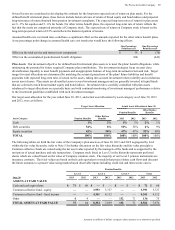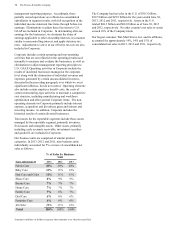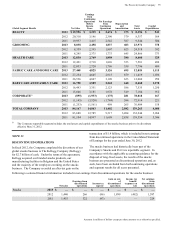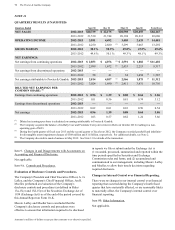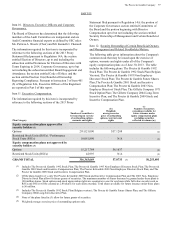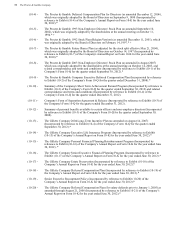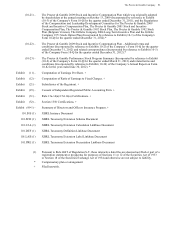Proctor and Gamble 2013 Annual Report Download - page 73
Download and view the complete annual report
Please find page 73 of the 2013 Proctor and Gamble annual report below. You can navigate through the pages in the report by either clicking on the pages listed below, or by using the keyword search tool below to find specific information within the annual report.
The Procter & Gamble Company 71
Amounts in millions of dollars except per share amounts or as otherwise specified.
number of preferred shares outstanding at June 30 was as
follows:
Shares in thousands 2013 2012 2011
Allocated 45,535 50,668 52,281
Unallocated 9,843 11,348 13,006
TOTAL SERIES A 55,378 62,016 65,287
Allocated 21,278 20,802 20,759
Unallocated 37,300 38,743 40,090
TOTAL SERIES B 58,578 59,545 60,849
For purposes of calculating diluted net earnings per common
share, the preferred shares held by the ESOP are considered
converted from inception.
NOTE 10
INCOME TAXES
Income taxes are recognized for the amount of taxes payable
for the current year and for the impact of deferred tax assets
and liabilities, which represent future tax consequences of
events that have been recognized differently in the financial
statements than for tax purposes. Deferred tax assets and
liabilities are established using the enacted statutory tax rates
and are adjusted for any changes in such rates in the period
of change.
Earnings from continuing operations before income taxes
consisted of the following:
Years ended June 30 2013 2012 2011
United States $ 8,351 $ 7,584 $ 8,858
International 6,492 5,201 6,139
TOTAL 14,843 12,785 14,997
Income taxes on continuing operations consisted of the
following:
Years ended June 30 2013 2012 2011
CURRENT TAX
EXPENSE
U.S. federal $ 1,885 $ 1,913 $ 1,770
International 1,584 1,374 1,149
U.S. state and local 279 246 256
3,748 3,533 3,175
DEFERRED TAX
EXPENSE
U.S. federal 180 83 200
International and other (487) (148) (76)
(307) (65) 124
TOTAL TAX EXPENSE 3,441 3,468 3,299
A reconciliation of the U.S. federal statutory income tax rate
to our actual income tax rate on continuing operations is
provided below:
Years ended June 30 2013 2012 2011
U.S. federal statutory income
tax rate 35.0 % 35.0 % 35.0 %
Country mix impacts of
foreign operations (7.6)% (8.1)% (8.2)%
Changes in uncertain tax
positions (1.8)% (1.3)% (3.6)%
Impairment adjustments 0.6 % 3.7 % — %
Holding gain on joint venture
buy-out (1.4)% —% —%
Other (1.6)% (2.2)% (1.2)%
EFFECTIVE INCOME
TAX RATE 23.2 % 27.1 % 22.0 %
Changes in uncertain tax positions represent changes in our
net liability related to prior year tax positions.
Tax costs charged to shareholders' equity totaled $503 for
the year ended June 30, 2013. This primarily relates to the
impact of certain adjustments to pension obligations
recorded in shareholders' equity, partially offset by excess
tax benefits from the exercise of stock options. Tax benefits
credited to shareholders' equity totaled $661 for the year
ended June 30, 2012. These primarily relate to the tax
effects of net investment hedges, excess tax benefits from
the exercise of stock options and the impacts of certain
adjustments to pension and other retiree benefit obligations
recorded in shareholders' equity.
We have undistributed earnings of foreign subsidiaries of
approximately $42.0 billion at June 30, 2013, for which
deferred taxes have not been provided. Such earnings are
considered indefinitely invested in the foreign subsidiaries.
If such earnings were repatriated, additional tax expense
may result. However, the calculation of the amount of
deferred U.S. income tax on these earnings is not practicable
because of the large number of assumptions necessary to
compute the tax.










